Car 1 at Chicago History
Museum Gallery
One of the more unique historical "L" artifacts to survive today
is the first "L" car. Car 1 from the Chicago & South Side Rapid
Transit, the first "L" company, luckily was able to survive long
enough to be recognized by transit historians, professionals, and
fans for its importance and saved from the scrapper's torch. Later
restored but out of reach from most of the public, car is now on
display for all to see.
About the
Car | About
the Move | About
the Exhibit |
Photos
About the
Car
Car 1, Chicago's first rapid transit passenger car, was part of an
order for 180 cars purchased by the Chicago & South Side Rapid
Transit Railroad Company. Ordered on February 15, 1892 from the
Jackson & Sharp company, the cars were trailers built to be
hauled behind steam locomotives.
The cars were of wood construction and had center end doors with
open platforms at each end of the car and railroad-style roofs with
stained glass clerestories. The cars, as delivered, were painted dark
Pullman green and had intricate stripping and gold leaf decoration on
the exterior. The railroad's name was spelled out in gold lettering
along the letterboard -- the long, thin, horizontal space on the
carside between the tops of the windows and the roof -- with a unique
peculiarity: a period at the end of the name.
The interiors were luxurious and typically Victorian, with
varnished woodwork, ornate light fixtures, decorative ceiling trim,
slatted window shades, cork floor mats, rattan seats, and leather
straps hung from the ceiling for standees. Originally, the cars were
heated by steam from the locomotives, circulated in the cars through
pipes, and were lit by gas lights supplied from tanks under the car
floor. The cars weighed 42,500 pounds; were 46 feet long, 8 feet 9.75
inches wide, and 12 feet 10 inches high; and seated 46 people.
After electric traction became a proven technology, most transit
companies were quick to covert to the more cost-effective form of
power. The SSRT, which became the South Side
Elevated Railroad in 1897 following the bankruptcy of the
original company, also tested another technology as part of the
conversion to electric traction: multiple-unit (MU) control. MU,
developed by inventor Frank Julian Sprague, allowed the controls in
one car to control the motors and brakes of every car in a train
consist. The South Side Elevated was the first application of MU
control, which became standard equipment on rapid transit cars.
One hundred twenty of the 180 original cars, including Car 1, were
converted into motor car in late 1897 and early 1898, mostly at the
Pullman Car Company in Chicago, with addition of two motors on one
truck of each car and the installation of a standard drum-type hand
controller. Because the cars were not designed as motor cars, a
motorcab had to be retrofit into the 120 cars. This was accomplished
by partitioning off the right corner of each end of the passenger
compartment of the car to make a small cab for the motorman. At the
time of conversion to motorcars, the gas lights were also replaced by
electric lights and Gold electric heaters were installed in place of
the steam heat units.
The 1-180 series motorcars were retired by 1930. From 1930-39, the
cars were stored in Lower
63rd Yard, where they were allowed to deteriorate. Most were
scrapped in 1939, but Car 1 was moved to Lower
Wilson Yard and stored there for many years. When Lower
Wilson closed in the 1950s, car 1 was moved to Skokie
Shops, where it sat for several more years.
In 1959, CTA staff
partially restored the car, retaining the inside motorman's cab and
original seating configuration. The car was further renovated in the
early 1960s. While the car still had much of its original fabric, it
had also significantly deteriorated and required extensive work. Most
of the exterior siding needed to be replaced and many of the
intricate brass fittings had to be recreated. To the extent
practical, the car was restored to its original condition, save for
the fact that it retained its motor equipment. However, it was no
longer able to operate under its own power. Therefore, it is perhaps
more precise to say that it was restored to its 1897 appearance.
One of the car's early public appearances after restoration was at
the 1962 opening of the new Desplaines
Shops. The site of the Victorian car going down the new, modern
Congress Line was
quite a juxtaposition! Later, the car was moved to the former
Lincoln-Wrightwood car barn, a former streetcar barn across Sheffield
Avenue from the "L"'s North
Side Main Line (today the Red and Brown lines) that housed the
CTA's historic equipment
collection, which included "L" cars, streetcars and buses.
The car moved around periodically for several decades while making
occasional public appearances. Car 1 was later moved to 61st
Yard. Car 1 came out for certain events, such as Mayor Byrne's
"Loop Alive" celebrations, the 100th anniversary of the "L" in 1992
and the 100th
anniversary of the Loop/50th anniversary of the
CTA in 1997. On these
occasions, the car was pulled by 4000-series
Historic Cars 4271-4272, which have compatible couplers. Around 2000,
Car 1 was moved to Skokie
Shops and storied there. However, it did not made any more public
appearances in large because, although it still looks good, there
were concerns on CTA's part
about the unit's road-worthiness.
About the
Move
On December 5, 2005, the Chicago
Historical Society closed for renovation. The museum would reopen
with completely revamped exhibition and galley spaces and a new name,
the Chicago
History Museum. As part of the overhaul of the museum's exhibits
about Chicago history, the museum decided that they wanted to include
one of best-known and beloved parts of Chicago culture, the "L".
By that time, Car 1 was little seen by the public, spending most
of its time protected from the elements inside maintenance shops.
Since the car was last out on the "L" for public rides at the Loop
Centennial in 1997, the car aged and the
CTA determined it too be too
risky to allow to mingle amongst the heavier steel cars of the
current fleet. For the most part, the car was only seen during the
CTA's annual transit rodeo
competition and open house, held at Skokie
Shops.
The CTA was, however,
amenable to loaning the car out to be displayed for the public. Talks
were at one time being held with the Museum
of Science and Industry for this purpose, but they did not come
to fruition. Finally, it was the Chicago
Historical Society that agreed to take the car and display it as
part of the museum's new exhibition space. Officially, the car is
still owned by CTA and is on
long-term loan to the History
Museum.
Once the museum's renovation had reached a certain stage and the
structure of the second floor, where it would be housed, had been
sufficiently reinforced to bear the weight of the car, Car 1 had to
be moved from CTA's Skokie
Shops to the Chicago
History Museum at North and Clark in Lincoln Park. Before the car
left, certain preparations were made. The only alteration done to the
car to make it "museum friendly" was rewiring it to allow its lights
to operate on standard 110 volt alternating current, instead of the
600 volts of direct current used on the "L." The work was performed
by CTA employees at Skokie
Shops.
During the month leading up to the move, museum personnel
performed conservation tasks and prepared a written assessment of
both the interior and exterior conditions. Conservation included
inspection of the car's sides and roof and then injection of special
adhesive where the paint was blistered or broken and loose. The
adhesive was let set for a day or so and then low heat and pressure
were applied to adhere the paint to the wood. A written assessment
was prepared of the car's condition both inside and out to have a
record of exactly how the car looked when it was moved. Broken seat
covering, wear and scuff marks, missing pieces, broken glass, gouges,
and other items were recorded for future reference.
After these steps were completed, the moving contractor, Belding
Walbridge, wrapped the car for shipment. This consisted of putting a
layer of foam plastic on the roof and part way down the sides to
protect the car from scrapes or light impacts during the move. This
was important because of the numerous low tree branches encountered
along the route. Then sheet plastic was placed over the car and both
ends and under the center to protect it from rain or snow. To hold
all this in place, shrink wrap was placed around the car from end to
end and around the middle from top to bottom. Finally a tarp was
placed over the car and tied to the carrying platform.
Once this was completed, Car 1 was ready for shipment. The big day
was January 18, 2006. A special carrying/lifting platform was built
to hold the car since it had to be lifted up to the second story
level at the museum to be rolled into the exhibit area. This platform
was placed outside Skokie
Shops and a ramp was placed to permit the car to be rolled up
onto the platform. This was accomplished the same way the
CTA had loaded the 2600-series
cars onto trailers for shipment to Alstom for rehab. Once on the
platform, the car was secured with welded chocks under the wheels,
steel framework around the trucks, steel posts under the side sills
and nylon straps tying the body bolster down to the platform to
prevent rocking during shipment. Since the car weight is not the same
at both ends -- one end has the motors while the other does not --
extra weights were added to the platform to help balance the
load.
A large 250-ton crane was used to lift the car on the platform
onto a low truck for shipment. Unfortunately, the truck was not in
the best of condition and it sagged under the weight of the car and
grounded itself in the Skokie
Shops loading area. Steel 'I' beams were placed from end to end
of the platform and chains were attached to the truck frame to hold
it up. This gave just enough ground clearance to permit the move.
The transport was originally scheduled to leave Skokie
Shops around 8am, but due to the low-trailer problem, the move
did not leave until 2:30pm. The shipment took a particularly
circuitous route because it had to avoid certain obstructions, most
notably low viaducts. Ironically, the "L" car, when on a trailer, is
too high to clear most "L" structures. The Illinois Department of
Transportation (IDOT) had to sign off on the special routing and
issue permits because of the size of the car.
The original route from Skokie was to be up McCormick Boulevard to
Green Bay Road, then through Evanston, Wilmette and Kenilworth before
heading over Kenilworth Avenue to Sheridan Road (the car went that
car north because it was the first place to cross the Metra/Union
Pacific-North Line that wasn't either too low of a viaduct or too
severe of a hill leading to a grade crossing). From there, the car
was to go back down south on Sheridan Road into Chicago, then over
private drives on the Loyola University Lake Shore campus in Rogers
Park (to avoid passing under the Red
Line viaducts at Sheridan/Loyola and Devon/Broadway, which were
too low to clear the trailer) and down Lake Shore Drive to the museum
at North Avenue. Loyola was consulted; it is unclear if they agreed
to the routing or not. Whatever the case, this was not the routing
that was finally used.
The route that Car 1 traversed was similar to the one above up to
the point where the car was heading south on Sheridan Road in
Evanston. At that point, the car went south on Chicago Avenue and
continued on Clark Street in Chicago. The transport veered down
Ashland Avenue south of Devon and successfully passed under the
Brown Line at Newport
because the elevated structure is unusually high there to pass over
the Metra/Union Pacific-North Line a few blocks west. From there, the
route followed Clybourn, Division, Orleans, Grand, and LaSalle, where
the truck turned right down Clark Street to reach the museum at Clark
and North. Low trees and the steep slope down from Sheridan Road and
Isabella in Evanston took some time to negotiate and traffic backed
up in both directions while the intersection was blocked. The truck
had to run against traffic in several places to avoid low tree limbs
and traffic signals. The move all the way down to Grand Avenue was
necessary because is another of the few locations where high loads
can get under the "L".
Car 1 arrived at the History
Museum at 6pm. The CTA approved for their bus turnaround at Clark and North to be used for
the truck to drive onto museum property.
CTA bus supervision cleared
the loop and rerouted North Avenue and Armitage Avenue buses to allow
the move. The car spent the night on its trailer parked outside the
south side of the museum building.
The next day, January 19, 2006, Car 1 was lifted up into the
museum's second floor. The Park
District had to approve the placement of cranes on its property
to facilitate the move. The move began around 8am as the car and
platform were lifted from the truck onto a short piece of elevated
structure outside the second story of the building and placed on
roller dollies so that it could be gently pulled into the building.
This actually involved three moves.
The first move allowed the flatbed trailer that brought Car 1 from
Skokie Shops to
be moved out from under it. The second put it back in position for
crews to remove some of the wood used to stabilize the car during the
move, strengthen welds on the steel bracing that kept it in place and
check for any other problems. The third time, a giant 400-ton crane
lifted the "L" car more than 20 feet off the ground, turned it 45
degrees, and then placed it gently into atop the temporary yellow
structure, from which it was pulled inside.
Over the next week, the car was moved inside the building and
placed in its final location. This required the car to be turned 90
degrees (from north-south to east-west) in a very tight space without
touching the interior walls or columns. It was then be jacked up with
small hydraulic jacks under the axles so that the rollers and
platform can be removed and it can be lowered onto the permanent
supports rails on the exhibition hall floor. In order to support the
car, the museum has had to install new support beams and columns
where the car was placed.
After more than a century, Chicago's first "L" car reached what
may be its final destination.
About
the Exhibit
Car 1 is the centerpiece of a new permanent exhibit at the
Chicago History
Museum called "Chicago: Crossroads of America". The exhibit
explores Chicago history and development, and well as its influence
on other cities and aspects of national culture. Also part of the
exhibit is the historic Galena & Chicago Union locomotive
"Pioneer" -- the locomotive from the first train to enter Chicago in
1848 -- which was already in the museum's collection. Five galleries
in the exhibit look at Chicago's economy, Chicago crises, Chicago
neighborhoods, innovations that Chicagoans gave the world and Chicago
as a hub of entertainment and culture.
Opening on September 30, 2006, Car 1 greets visitors when the
first enter the exhibit. The car stands at a replica South Side Rapid
Transit platform, complete with a replica of the SSRT's short-lived
humpbacked platform canopy, with accessible ramp at one end to allow
visitors to look into the car. The car is open to the public, who are
welcome to walk through it.
On the platform are three figurines: One represents a common
laborer, in this case one of the ironworkers who built the first
Ferris Wheel for the World's Columbian Exposition. Another is based
on a Wisconsin woman whose letters home about the 1893 World's Fair
have been preserved in the museum's archives. The third will be Ida
B. Wells, the early civil rights crusader of the era who spoke out
against the exclusion of African-Americans from the Fair. A
prerecorded conversation among the three based on the letters and
Wells' statements plays from speakers overhead.
Thanks to First & Fastest magazine (Summer 2006
issue), Walter Keevil, Bruce Moffat, and Robert Bresse-Rodenkirk for
information for this article.
Photos
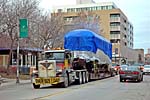
|
ssrt1-CHMmove01.jpg
(187k)
A tractor-trailer carrying SSRT car 1 to its new home at the
Chicago
History Museum passes by the Main
station on the Purple
Line during the afternoon of January 18, 2006. Note that
the move is protected by vehicles in front (left, out of
frame) and behind the truck. The car passed under the "L"
structure three times during its journey.
(Photo by Bruce G. Moffat)
|
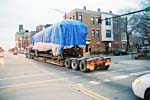
|
ssrt1-CHMmove02.jpg
(155k)
Car 1 is on the move on January 18, 2006, heading southbound
on Ashland Avenue as it passes 3400 North.
(Photo by Robert
Bresse-Rodenkirk)
|
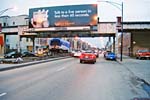
|
ssrt1-CHMmove03.jpg
(157k)
Car 1 passes underneath the Ravenswood
branch of the Brown
Line as its heads south on Ashland Avenue on January 18,
2006. This location was one of the few where the car could
make the clearance under the elevated. At this point, the
Brown Line
is ascending to pass over the elevated tracks of the
Metra/Union Pacific-North Line. (Photo by
Robert Bresse-Rodenkirk)
|
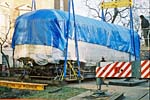
|
ssrt1-CHMmove04.jpg
(218k)
Car 1 has reached its destination and is now being prepared
for the next phase: its lift into the building. In this view
on the evening of January 18, 2006, the car is resting on
its the trailer, ready to be lifted into the museum the
following day. (Photo by Robert
Bresse-Rodenkirk)
|
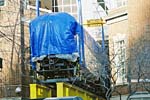
|
ssrt1-CHMmove05.jpg
(234k)
The next phase is now underway: On the morning of January
19, 2006, Car 1 is being lifted off its trailer and set on
the platform to be rolled into the second floor of the
Chicago
History Museum. (Photo by Robert
Bresse-Rodenkirk)
|

|
ssrt1-CHMmove06.jpg
(210k)
This long-angle view shows Car 1 being moved into the museum
by crane on its special platform on January 19, 2006.
(Photo by Robert
Bresse-Rodenkirk)
|
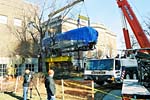
|
ssrt1-CHMmove07.jpg
(261k)
Now lifted to the second story of the museum building, the
process has begun for slowing rolling Car 1 into the
exhibition space through an opening in the exterior wall of
the building on January 19, 2006. (Photo by
Robert Bresse-Rodenkirk)
|
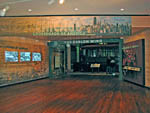
|
ssrt1-CHMexhibit01.jpg
(191k)
Entering the "Chicago: Crossroads of America" exhibit on the
second floor of the Chicago
History Museum, visitors are immediately greeted by Car
1. This view looks south into the exhibit from the main
hallway on October 28, 2006. (Photo by
Graham Garfield)
|
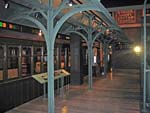
|
ssrt1-CHMexhibit02.jpg
(185k)
Car 1 is presented to visitors in context with a replica of
an original South Side Rapid Transit platform, including the
SSRT's original humpbacked canopy. These canopies were
replaced with flat ones fairly early on, so detailed
information on them was scarce. Several "L" historians,
including Bruce Moffat and Graham Garfield, worked with the
History Museum to provide documents, drawings, and photos
that allowed as accurate a recreation as possible.
(Photo by Graham Garfield)
|
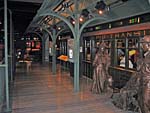
|
ssrt1-CHMexhibit03.jpg
(188k)
Along with the reproduction platform and canopy, visitors
are presented with three figures -- a laborer, a visitor to
the Columbian Exposition from Wisconsin, and civil rights
activist Ida B. Wells -- to help interpret the era. There
are also audio and visual displays to read and experience.
(Photo by Graham Garfield)
|

|
ssrt1-CHMexhibit04.jpg
(196k)
A long view of the exhibit shows the car, canopy, platform
with lights, and accessible ramp that make up the Car 1
exhibit on October 28, 2006. The wall above the exhibit is a
photo of a two-car "L" train crossing the Chicago River.
(Photo by Graham Garfield)
|
|

|

|













